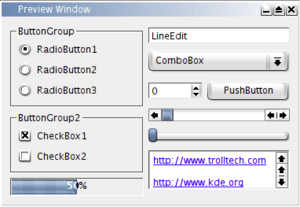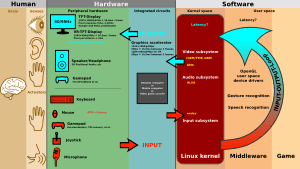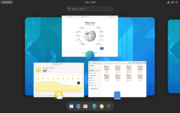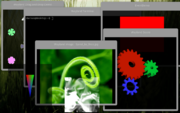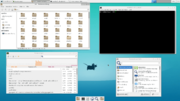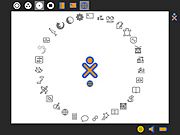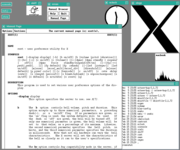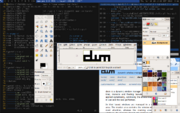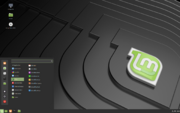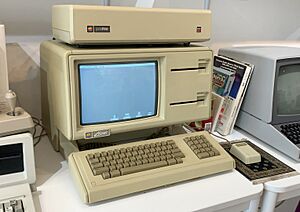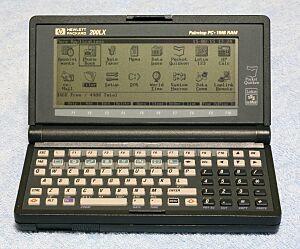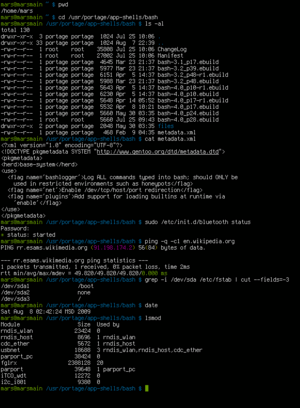Graphical user interface facts for kids
A graphical user interface, or GUI (pronounced "gooey" or "gee-you-eye"), is a way for you to interact with electronic devices. Instead of typing commands, you use visual things like pictures, icons, and menus. GUIs were created because typing commands into a command-line interface (CLI) could be hard to learn.
You can find GUIs on many devices, not just computers. They are on mobile devices like smartphones, MP3 players, and even on controls for things in your home or at work. The term GUI usually refers to 2D screens that show general information, like the ones developed at the Xerox Palo Alto Research Center. It doesn't usually refer to video games, which often use HUDs, or special 3D displays.
Contents
Designing GUIs
Designing a GUI is a big part of making software applications. It's all about making a program easy and efficient to use. This design area is called usability. Designers try to make sure the visual look of the GUI matches the tasks you want to do.
The visual parts of an application are sometimes called its chrome or GUI. You interact with information by using visual tools called widgets. These widgets are chosen to help you do what you need to do. For example, a window might hold a web page, while a smaller widget like a button helps you click something.
Some GUIs are made for specific jobs. Think about automated teller machines (ATMs), touchscreens at restaurants, or self-service checkouts at stores. Even cell phones and car navigation systems use special GUIs.
Examples of GUIs
- Sample graphical environments
-
A twm X Window System environment
Parts of a GUI

A GUI uses different technologies to let you gather and create information. Over time, certain visual elements have become common to show information on computers. This makes it easier for people who aren't computer experts to use software.
The most common set of elements in GUIs is called the windows, icons, text fields, canvases, menus, pointer (WIMP) system. This is especially true for personal computers.
The WIMP style uses a pointing device like a computer mouse to control a pointer on the screen. Information is shown in windows and represented by icons. Commands you can use are grouped in menus. You perform actions by moving the pointer and clicking. A window manager helps windows and applications work together.
On personal computers, these elements often look like a desktop metaphor. This means the screen looks like a desk where you can place documents and folders.
Newer GUI Styles
Smaller mobile devices like personal digital assistants (PDAs) and smartphones use WIMP elements but adapt them for smaller screens and different ways of input. For example, touchscreen-based operating systems like Apple's iOS (on iPhones) and Android use a newer style called post-WIMP. These allow you to use more than one finger to interact with the screen, doing things like pinching to zoom or rotating images.
How You Interact
You interact with a GUI using Human interface devices. These include a computer keyboard, especially with keyboard shortcuts. You also use pointing devices to control the pointer, such as a mouse, touchpad, or trackball. Some devices use virtual keyboards or head-up displays.
Programs can also affect the GUI. For example, special parts of the system like D-Bus help different computer programs talk to each other.
History of GUIs
Early Ideas
The idea of GUIs started a long time ago. In 1963, Ivan Sutherland created Sketchpad, which was one of the first programs to let you draw and move objects on a computer screen using a light pen. In the late 1960s, Douglas Engelbart and his team at the Stanford Research Institute developed the On-Line System (NLS). This system used text links and a new device: the mouse. A famous demonstration of NLS in 1968 is known as "The Mother of All Demos".
In the 1970s, researchers at Xerox PARC, especially Alan Kay, took these ideas further. They used a GUI as the main way to interact with the Smalltalk programming language on the Xerox Alto computer, released in 1973. Many modern GUIs come from this system.
The Xerox PARC GUI had windows, menus, radio buttons, and check boxes. Icons were added later. These early systems used a pointing device and a keyboard. The first computer with a GUI that was sold was the 1979 PERQ workstation. In 1981, Xerox sold their own system, the Xerox Star.
These early GUIs inspired many others. The Apple Lisa (1983) introduced the idea of a menu bar and window controls. The Apple Macintosh 128K (1984), Atari ST (1985), and Commodore Amiga (1985) also had GUIs. Many of these ideas were used by Apple, IBM, and Microsoft to create their own products. This led to the GUIs we see today in Microsoft Windows, macOS, and Linux.
Becoming Popular
GUIs became a big topic in the early 1980s. The Apple Lisa came out in 1983. Even though GUIs had advantages, some people wondered if they were truly useful because of hardware limits and finding compatible software.
In 1984, Apple released a famous TV commercial during the Super Bowl, introducing the Apple Macintosh. This commercial made people think differently about computers, showing the Macintosh as a user-friendly computer for everyone.
In 1985, Commodore released the Amiga 1000 with its GUI, Workbench. This GUI was very responsive and didn't freeze when a program was busy. It was also one of the first to have something like Virtual Desktops.
Windows 95 was a huge success when it launched and quickly became the most popular desktop operating system.
In 2007, Apple's iPhone, and later the iPad in 2010, made the post-WIMP style of interaction popular for multi-touch screens. These devices were very important for the development of mobile devices.
Today, the GUIs most people know are Microsoft Windows, macOS, and X Window System interfaces for desktop computers. For phones, popular GUIs include Android, Apple's iOS, and Windows Phone/Windows 10 Mobile.
GUI vs. Command-Line Interfaces
Command-line interfaces (CLIs) let you do complex things with short commands. They are very efficient once you learn them. However, it takes time to learn all the commands, and they can be slow if you have to type long commands or many file names.
GUIs, on the other hand, show you many widgets that represent commands. This makes them easier to learn and use right away. But sometimes, important settings can be hidden deep in menus, and it can be harder to automate tasks with GUIs compared to CLIs.
Most modern operating systems offer both a GUI and a CLI. The GUIs usually get more attention.
GUI Wrappers
Sometimes, a GUI is built on top of a command-line program. This is called a GUI wrapper. It lets you use a program with graphical icons and visual indicators, even if the program was originally designed to be used by typing commands. This helps people avoid the steep learning curve of command-line programs. Many programs for Unix-like operating systems offer both a command-line version and a GUI wrapper.
3D Graphical User Interfaces
Many computer environments and games use 3D graphics to show 3D GUI objects on the screen. Using 3D graphics has become common in operating systems like Windows Aero and Aqua (macOS). This is often to make the interface look more attractive, with things like drop shadows. But it can also be for useful purposes that only 3D can provide. For example, switching between users might look like rotating a cube, or managing windows might look like flipping cards.
The GUI is usually WIMP-based, but sometimes other ideas appear. Zooming (ZUI) is a technology that tries to give the benefits of 3D without the problems of getting lost or having hidden objects. Other new ideas include menus on game consoles like the PlayStation 2 and Xbox, and special compositing window managers like Enlightenment and Compiz. Augmented reality and virtual reality also use 3D GUI elements.
3D GUIs in Science Fiction
3D GUIs have been shown in science fiction books and movies even before they were possible in real life.
- In books, 3D GUIs have been described as immersive worlds, like William Gibson's "cyberspace" and Neal Stephenson's "metaverse" with "avatars".
- The 1993 film Jurassic Park showed Silicon Graphics' 3D file manager, File System Navigator, which was a real program for Unix operating systems.
- The film Minority Report showed police officers using special 3D data systems.
See also
 In Spanish: Interfaz gráfica de usuario para niños
In Spanish: Interfaz gráfica de usuario para niños
- Console user interface
- Computer icon
- Human factors and ergonomics
- Look and feel
- Natural user interface
- Object-oriented user interface
- Text entry interface
- User experience design
- User interface design


